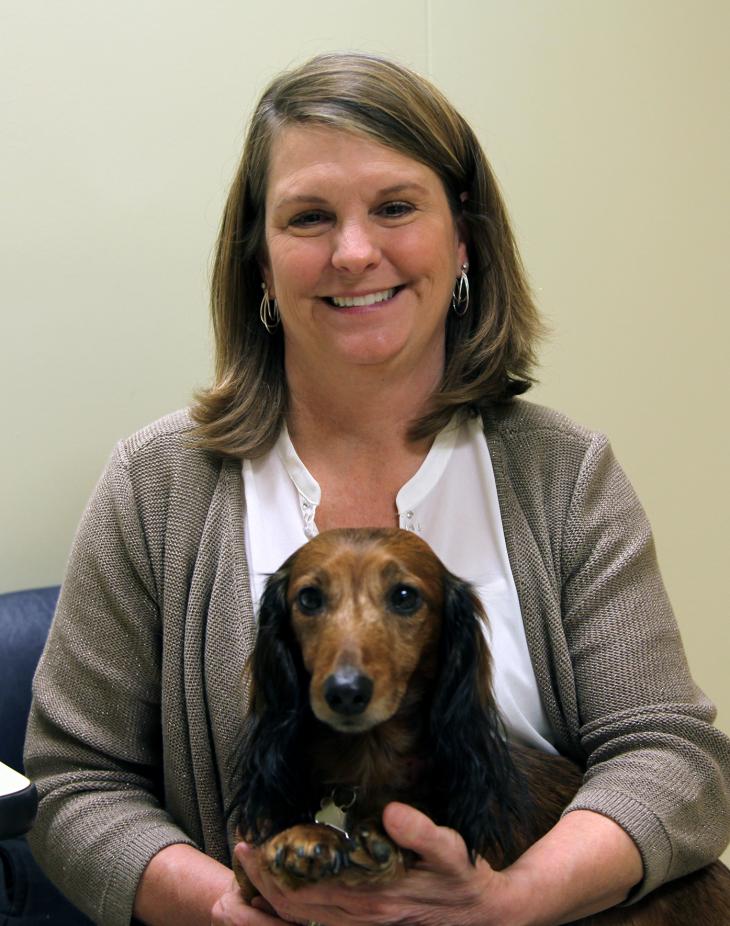
Rosie's Journey
Thursday, March 19, 2015
Shelley Wilmoth lives in Fayetteville, Ark. She has a soft spot for Dachshunds. She has rescued two male Dachshunds and Rosie Claire, a long haired Dachshund with big eyes that have seen way too much in her short lifetime.
“Rosie is approximately 2 years old,” Wilmoth says. “When we adopted her in the fall of 2014 from Fayetteville’s Washington County Shelter, she had a bad back and could only walk a little bit. We took her to a veterinarian and an x-ray showed she has a pellet in her chest. So at some point in her life, she was shot with a pellet gun. She has probably had a hard time.”
But things are looking up for Rosie’s future. Wilmoth brought Rosie to Oklahoma State University’s Veterinary Medical Hospital in February 2015 to see if the dog was a good candidate for percutaneous laser disk ablation surgery. The surgery is a prophylactic procedure developed by Dr. Ken Bartels as a way to lessen the risk of intervertebral disk rupture in dogs. It is performed only on dogs that are currently free of back pain; some have had prior episodes of pain or paralysis while others are just dogs that are at risk for disk rupture. Recurrence of back pain or paralysis without this procedure may be as high as 40 percent.
“The disk is like a jelly donut with a tough outer layer and jelly-like material on the inside,” explains Mark Rochat, DVM, MS, Diplomate of the American College of Veterinary Surgeons and the small animal surgery section chief at OSU’s Veterinary Medical Hospital. “We insert a needle into each disk that needs treatment and then insert a laser fiber through the needle. Laser energy is delivered through the fiber to ‘burn away’ the inside (jelly) material so that it cannot rupture through the outer layer, compress the spinal cord and cause pain or paralysis. It’s a minimally invasive procedure with no surgical opening, just the tiny holes made by the needles.”
Dr. Rochat determined that Rosie was a good candidate for the laser surgery. She spent one night in the hospital and will then spend the next two weeks confined to a crate at the Wilmoth’s home while she recovers.
“I think it will definitely help her quality of life,” adds Wilmoth. “Right now, we don’t let her sprint across the yard. We don’t let her jump up on furniture. We have ramps in the house and out to the yard even though it is just two steps off the deck. She needs to be a normal dog; I’m hoping surgery will do that.”
“The length of surgery varies from dog to dog,” Rochat says. “The needle placement is the unknown factor; sometimes it takes longer than other times to place them. Firing the laser is 40 seconds for each needle with time in between to double check the placement. Rosie will have eight needles.”
Rosie’s procedure took about one hour. Even though Wilmoth’s friends have had the procedure done on their dogs with great success, she was still anxious about Rosie’s operation.
“It was elective surgery so it was very difficult for us to do this. Even though it was elective, I feel like it was not elective in the sense if I wanted Rosie to have a normal dog life. She wants to be able to play with other dogs. She has two brothers and they don’t play a whole lot. If you have ever seen a Dachshund with back pain, their nose is to the ground and their back is hunched and you know it’s extremely painful.”
As Wilmoth is reunited with Rosie, she says that the veterinarians told her Rosie did great.
“The doctors and staff are wonderful. They explained the risks, the process of what they were going to do and they communicated with me. I have been in contact with the veterinary student on the case a lot, which has been wonderful. They called me after surgery and said Rosie came out of anesthesia, walked around and went to the bathroom. Now comes the tough part of keeping her on crate rest for the next two weeks. But it’s worth it. If she can have a lifetime of running across the yard and chasing balls and us not having to worry about her back going out, we can get through two weeks of crate rest. It was a success and I’m glad we did it.”
For more information on laser disk surgery, contact Oklahoma State University’s Veterinary Medical Hospital at 405-744-7000.
